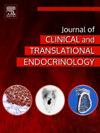治疗囊性纤维化相关性糖尿病成人患者胰岛素剂量调整的血红蛋白A1c
IF 3.3
Q1 ENDOCRINOLOGY & METABOLISM
Journal of Clinical and Translational Endocrinology
Pub Date : 2025-07-02
DOI:10.1016/j.jcte.2025.100407
引用次数: 0
摘要
2019年,delexacaftor - tezactor -ivacaftor (ETI)开始用于囊性纤维化(CF)成人患者,但其对CF相关糖尿病(CFRD)的影响尚不清楚。方法对成年CFRD患者进行单中心回顾性队列研究,观察胰岛素剂量调整血红蛋白A1c (IDAA1c)的变化。采用线性混合效应模型(LMEM)分析研究基线和随访24个月期间IDAA1c的变化,并将eti治疗组与未暴露组进行比较。基线值是治疗组在治疗开始时和未暴露组在2020年3月(±3个月)记录的基线值。结果共纳入49例成人,其中39例经ETI治疗,10例未行ETI治疗。基线诊断CFRD的中位时间[四分位数范围]分别为13[7-18]和14[10-18]年(p = 0.610)。在eti治疗组,平均体重增加了4.44 kg(95%置信区间,95% CI: 3.08至5.79,p <;0.001),胰岛素总日剂量降低了5个单位(95% CI: - 9 ~ 0, p = 0.033),血红蛋白A1c(%)降低了0.65点(95% CI: - 0.96 ~ - 0.34, p <;0.001)。未暴露组未观察到任何变化。LMEM分析发现,在调整年龄、性别、CFRD诊断后的时间和引入二甲双胍后,ETI和IDAA1c降低之间存在显著的数值相关性,估计为- 1.14点(95% CI: - 2.35至0.06,p = 0.067)。结论在治疗24个月后,确诊CFRD的成人患者观察到ETI与IDAA1c降低之间的数值显著相关,表明ETI有助于改善血糖控制。本文章由计算机程序翻译,如有差异,请以英文原文为准。
Decreased insulin dose-adjusted hemoglobin A1c in adults with cystic fibrosis-related diabetes treated with elexacaftor-tezacaftor-ivacaftor
Background
Elexacaftor-tezacaftor-ivacaftor (ETI) became available for adults with cystic fibrosis (CF) in 2019, but its impact on CF-related diabetes (CFRD) remains unclear.
Methods
A single-center retrospective cohort study was conducted among adults with CFRD to examine the change in insulin dose-adjusted Hemoglobin A1c (IDAA1c). Linear mixed effects model (LMEM) analysis was used to investigate the change in IDAA1c between baseline and 24 months of follow up, comparing an ETI-treated group to an unexposed group. Baseline values were those documented at treatment initiation for the ETI-treated group and in March 2020 (±3 months) for the unexposed group.
Results
A total of 49 adults were included, 39 were treated with ETI and 10 were not. Median [Interquartile range] time since CFRD diagnosis at baseline was 13 [7–18] and 14 [10–18] years, respectively (p = 0.610). In the ETI-treated group, mean weight increased by a 4.44 kg (95 % Confidence Interval, 95 %CI: 3.08 to 5.79, p < 0.001), insulin total daily dose decreased by 5 units (95 %CI: −9 to 0, p = 0.033), and hemoglobin A1c (%) decreased by 0.65 points (95 %CI: −0.96 to −0.34, p < 0.001). No change was observed in the unexposed group. LMEM analysis found a numerically significant association between ETI and decreased IDAA1c, estimated at −1.14 points (95 %CI: −2.35 to 0.06, p = 0.067) after adjusting for age, sex, time since CFRD diagnosis and the introduction of Metformin.
Conclusion
A numerically significant association between ETI and IDAA1c decrease was observed in adults with established CFRD after 24 months of treatment, suggesting ETI contributed to improved glycemic control.
求助全文
通过发布文献求助,成功后即可免费获取论文全文。
去求助
来源期刊

Journal of Clinical and Translational Endocrinology
ENDOCRINOLOGY & METABOLISM-
CiteScore
6.10
自引率
0.00%
发文量
24
审稿时长
16 weeks
 求助内容:
求助内容: 应助结果提醒方式:
应助结果提醒方式:


